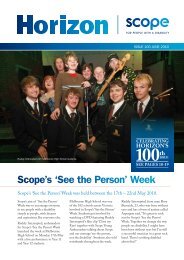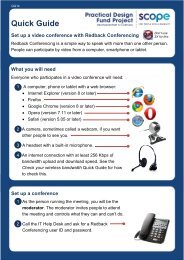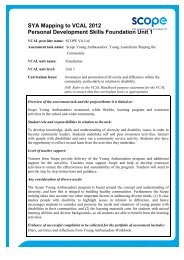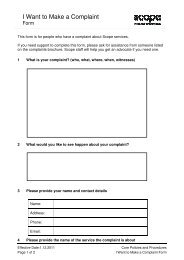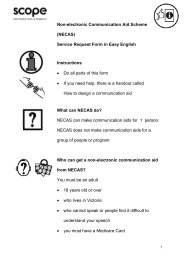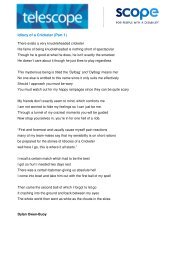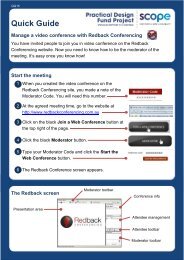Positive behaviour support Getting it right from the start
Positive behaviour support Getting it right from the start
Positive behaviour support Getting it right from the start
Create successful ePaper yourself
Turn your PDF publications into a flip-book with our unique Google optimized e-Paper software.
<strong>Pos<strong>it</strong>ive</strong> <strong>behaviour</strong> <strong>support</strong>: <strong>Getting</strong> <strong>it</strong> <strong>right</strong> <strong>from</strong> <strong>the</strong> <strong>start</strong> - Facil<strong>it</strong>ators reference manual 73<br />
Some means of communication:<br />
In order to communicate a person needs to have a means of communication. If <strong>the</strong> person does<br />
not have speech, <strong>it</strong> is very important to learn <strong>the</strong> meaning behind <strong>the</strong> person’s unique methods<br />
of communication and systematically introducing AAC systems.<br />
Someone to communicate w<strong>it</strong>h:<br />
Although this appears qu<strong>it</strong>e obvious, often people w<strong>it</strong>h complex communication needs seldom<br />
have a person who really takes <strong>the</strong> time to chat. Communication may be slow or <strong>the</strong> person may<br />
prefer not to communicate ra<strong>the</strong>r than experience frustration or failure. It is <strong>the</strong>refore important<br />
for pos<strong>it</strong>ive relationships to be established as a means of ensuring <strong>the</strong> person becomes<br />
confident w<strong>it</strong>h <strong>the</strong>ir communication attempts.<br />
Make choices:<br />
This should be a routine part of all daily activ<strong>it</strong>ies. By having constant opportun<strong>it</strong>ies for decisionmaking<br />
and choice a person is encouraged to do things for <strong>the</strong>mselves.<br />
Activ<strong>it</strong>ies:<br />
Not having much to do that is personally enjoyable and based on <strong>the</strong> person’s strengths, doing<br />
things which are not very functional, not being taught in ways which set <strong>the</strong> person up to<br />
succeed.<br />
Predictabil<strong>it</strong>y:<br />
Not being able to predict activ<strong>it</strong>ies or what is happening next in <strong>the</strong>ir day.<br />
Delivery of instructions<br />
Information is conveyed in ways that <strong>the</strong> person finds hard to understand, e.g. <strong>support</strong> staff<br />
relying primarily on spoken language.<br />
PowerPoint Some key points to remember about <strong>the</strong> processing and interpreting of messages:<br />
99*<br />
• Speech only is very difficult to process and interpret.<br />
• People w<strong>it</strong>h a disabil<strong>it</strong>y have varying levels communicative abil<strong>it</strong>y and <strong>it</strong> important to know<br />
where on <strong>the</strong> communication continuum <strong>the</strong> person is.<br />
• Some people may be able to follow simple one stage commands, information in <strong>the</strong> here<br />
and now, <strong>the</strong> first or last thing that was said. O<strong>the</strong>rs may be processing information at a<br />
conversational level but having difficulty w<strong>it</strong>h abstract concepts such as humour, or taking<br />
everything that was said l<strong>it</strong>erally—are concrete thinkers.<br />
• Some people are very good at seeming like <strong>the</strong>y understand everything that is being said,<br />
when in fact <strong>the</strong>y are only processing b<strong>it</strong>s of information and relying heavily on your nonspeech<br />
cues and may misinterpret <strong>the</strong> intent of your message.<br />
• The abil<strong>it</strong>y to process and interpret messages can change depending on <strong>the</strong> person’s health<br />
and wellbeing, emotional state and number of distractions in <strong>the</strong> environment.<br />
• Some people may have difficulty processing information:<br />
- that is presented in <strong>the</strong> negative—for example, ‘Don’t run’ or ’You don’t like bananas do you?’<br />
- that is related to time, day or date (temporal relationships)<br />
- about who, what, where, when and why questions.



